編輯:關於android開發
上次我向大家介紹了SQLite的基本信息和使用過程,相信朋友們對SQLite已經有所了解了,那今天呢,我就和大家分享一下在Android中如何使用SQLite。
現在的主流移動設備像Android、iPhone等都使用SQLite作為復雜數據的存儲引擎,在我們為移動設備開發應用程序時,也許就要使用到SQLite來存儲我們大量的數據,所以我們就需要掌握移動設備上的SQLite開發技巧。對於Android平台來說,系統內置了豐富的API來供開發人員操作SQLite,我們可以輕松的完成對數據的存取。
下面就向大家介紹一下SQLite常用的操作方法,為了方便,我將代碼寫在了Activity的onCreate中:
@Override
protected void onCreate(Bundle savedInstanceState) {
super.onCreate(savedInstanceState);
//打開或創建test.db數據庫
SQLiteDatabase db = openOrCreateDatabase("test.db", Context.MODE_PRIVATE, null);
db.execSQL("DROP TABLE IF EXISTS person");
//創建person表
db.execSQL("CREATE TABLE person (_id INTEGER PRIMARY KEY AUTOINCREMENT, name VARCHAR, age SMALLINT)");
Person person = new Person();
person.name = "john";
person.age = 30;
//插入數據
db.execSQL("INSERT INTO person VALUES (NULL, ?, ?)", new Object[]{person.name, person.age});
person.name = "david";
person.age = 33;
//ContentValues以鍵值對的形式存放數據
ContentValues cv = new ContentValues();
cv.put("name", person.name);
cv.put("age", person.age);
//插入ContentValues中的數據
db.insert("person", null, cv);
cv = new ContentValues();
cv.put("age", 35);
//更新數據
db.update("person", cv, "name = ?", new String[]{"john"});
Cursor c = db.rawQuery("SELECT * FROM person WHERE age >= ?", new String[]{"33"});
while (c.moveToNext()) {
int _id = c.getInt(c.getColumnIndex("_id"));
String name = c.getString(c.getColumnIndex("name"));
int age = c.getInt(c.getColumnIndex("age"));
Log.i("db", "_id=>" + _id + ", name=>" + name + ", age=>" + age);
}
c.close();
//刪除數據
db.delete("person", "age < ?", new String[]{"35"});
//關閉當前數據庫
db.close();
//刪除test.db數據庫
// deleteDatabase("test.db");
}
在執行完上面的代碼後,系統就會在/data/data/[PACKAGE_NAME]/databases目錄下生成一個“test.db”的數據庫文件,如圖:

上面的代碼中基本上囊括了大部分的數據庫操作;對於添加、更新和刪除來說,我們都可以使用
db.executeSQL(String sql); db.executeSQL(String sql, Object[] bindArgs);//sql語句中使用占位符,然後第二個參數是實際的參數集除了統一的形式之外,他們還有各自的操作方法:
db.insert(String table, String nullColumnHack, ContentValues values); db.update(String table, Contentvalues values, String whereClause, String whereArgs); db.delete(String table, String whereClause, String whereArgs);以上三個方法的第一個參數都是表示要操作的表名;insert中的第二個參數表示如果插入的數據每一列都為空的話,需要指定此行中某一列的名稱,系統將此列設置為NULL,不至於出現錯誤;insert中的第三個參數是ContentValues類型的變量,是鍵值對組成的Map,key代表列名,value代表該列要插入的值;update的第二個參數也很類似,只不過它是更新該字段key為最新的value值,第三個參數whereClause表示WHERE表達式,比如“age > ? and age < ?”等,最後的whereArgs參數是占位符的實際參數值;delete方法的參數也是一樣。
下面來說說查詢操作。查詢操作相對於上面的幾種操作要復雜些,因為我們經常要面對著各種各樣的查詢條件,所以系統也考慮到這種復雜性,為我們提供了較為豐富的查詢形式:
db.rawQuery(String sql, String[] selectionArgs); db.query(String table, String[] columns, String selection, String[] selectionArgs, String groupBy, String having, String orderBy); db.query(String table, String[] columns, String selection, String[] selectionArgs, String groupBy, String having, String orderBy, String limit); db.query(String distinct, String table, String[] columns, String selection, String[] selectionArgs, String groupBy, String having, String orderBy, String limit);上面幾種都是常用的查詢方法,第一種最為簡單,將所有的SQL語句都組織到一個字符串中,使用占位符代替實際參數,selectionArgs就是占位符實際參數集;下面的幾種參數都很類似,columns表示要查詢的列所有名稱集,selection表示WHERE之後的條件語句,可以使用占位符,groupBy指定分組的列名,having指定分組條件,配合groupBy使用,orderBy指定排序的列名,limit指定分頁參數,distinct可以指定“true”或“false”表示要不要過濾重復值。需要注意的是,selection、groupBy、having、orderBy、limit這幾個參數中不包括“WHERE”、“GROUP BY”、“HAVING”、“ORDER BY”、“LIMIT”等SQL關鍵字。
下面是Cursor對象的常用方法:
c.move(int offset); //以當前位置為參考,移動到指定行 c.moveToFirst(); //移動到第一行 c.moveToLast(); //移動到最後一行 c.moveToPosition(int position); //移動到指定行 c.moveToPrevious(); //移動到前一行 c.moveToNext(); //移動到下一行 c.isFirst(); //是否指向第一條 c.isLast(); //是否指向最後一條 c.isBeforeFirst(); //是否指向第一條之前 c.isAfterLast(); //是否指向最後一條之後 c.isNull(int columnIndex); //指定列是否為空(列基數為0) c.isClosed(); //游標是否已關閉 c.getCount(); //總數據項數 c.getPosition(); //返回當前游標所指向的行數 c.getColumnIndex(String columnName);//返回某列名對應的列索引值 c.getString(int columnIndex); //返回當前行指定列的值
在上面的代碼示例中,已經用到了這幾個常用方法中的一些,關於更多的信息,大家可以參考官方文檔中的說明。
最後當我們完成了對數據庫的操作後,記得調用SQLiteDatabase的close()方法釋放數據庫連接,否則容易出現SQLiteException。
上面就是SQLite的基本應用,但在實際開發中,為了能夠更好的管理和維護數據庫,我們會封裝一個繼承自SQLiteOpenHelper類的數據庫操作類,然後以這個類為基礎,再封裝我們的業務邏輯方法。
下面,我們就以一個實例來講解具體的用法,我們新建一個名為db的項目,結構如下:
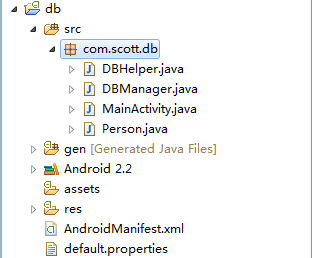
其中DBHelper繼承了SQLiteOpenHelper,作為維護和管理數據庫的基類,DBManager是建立在DBHelper之上,封裝了常用的業務方法,Person是我們的person表對應的JavaBean,MainActivity就是我們顯示的界面。
下面我們先來看一下DBHelper:
package com.scott.db;
import android.content.Context;
import android.database.sqlite.SQLiteDatabase;
import android.database.sqlite.SQLiteOpenHelper;
public class DBHelper extends SQLiteOpenHelper {
private static final String DATABASE_NAME = "test.db";
private static final int DATABASE_VERSION = 1;
public DBHelper(Context context) {
//CursorFactory設置為null,使用默認值
super(context, DATABASE_NAME, null, DATABASE_VERSION);
}
//數據庫第一次被創建時onCreate會被調用
@Override
public void onCreate(SQLiteDatabase db) {
db.execSQL("CREATE TABLE IF NOT EXISTS person" +
"(_id INTEGER PRIMARY KEY AUTOINCREMENT, name VARCHAR, age INTEGER, info TEXT)");
}
//如果DATABASE_VERSION值被改為2,系統發現現有數據庫版本不同,即會調用onUpgrade
@Override
public void onUpgrade(SQLiteDatabase db, int oldVersion, int newVersion) {
db.execSQL("ALTER TABLE person ADD COLUMN other STRING");
}
}
正如上面所述,數據庫第一次創建時onCreate方法會被調用,我們可以執行創建表的語句,當系統發現版本變化之後,會調用onUpgrade方法,我們可以執行修改表結構等語句。
為了方便我們面向對象的使用數據,我們建一個Person類,對應person表中的字段,如下:
package com.scott.db;
public class Person {
public int _id;
public String name;
public int age;
public String info;
public Person() {
}
public Person(String name, int age, String info) {
this.name = name;
this.age = age;
this.info = info;
}
}
然後,我們需要一個DBManager,來封裝我們所有的業務方法,代碼如下:
package com.scott.db;
import java.util.ArrayList;
import java.util.List;
import android.content.ContentValues;
import android.content.Context;
import android.database.Cursor;
import android.database.sqlite.SQLiteDatabase;
public class DBManager {
private DBHelper helper;
private SQLiteDatabase db;
public DBManager(Context context) {
helper = new DBHelper(context);
//因為getWritableDatabase內部調用了mContext.openOrCreateDatabase(mName, 0, mFactory);
//所以要確保context已初始化,我們可以把實例化DBManager的步驟放在Activity的onCreate裡
db = helper.getWritableDatabase();
}
/**
* add persons
* @param persons
*/
public void add(List persons) {
db.beginTransaction(); //開始事務
try {
for (Person person : persons) {
db.execSQL("INSERT INTO person VALUES(null, ?, ?, ?)", new Object[]{person.name, person.age, person.info});
}
db.setTransactionSuccessful(); //設置事務成功完成
} finally {
db.endTransaction(); //結束事務
}
}
/**
* update person's age
* @param person
*/
public void updateAge(Person person) {
ContentValues cv = new ContentValues();
cv.put("age", person.age);
db.update("person", cv, "name = ?", new String[]{person.name});
}
/**
* delete old person
* @param person
*/
public void deleteOldPerson(Person person) {
db.delete("person", "age >= ?", new String[]{String.valueOf(person.age)});
}
/**
* query all persons, return list
* @return List
*/
public List query() {
ArrayList persons = new ArrayList();
Cursor c = queryTheCursor();
while (c.moveToNext()) {
Person person = new Person();
person._id = c.getInt(c.getColumnIndex("_id"));
person.name = c.getString(c.getColumnIndex("name"));
person.age = c.getInt(c.getColumnIndex("age"));
person.info = c.getString(c.getColumnIndex("info"));
persons.add(person);
}
c.close();
return persons;
}
/**
* query all persons, return cursor
* @return Cursor
*/
public Cursor queryTheCursor() {
Cursor c = db.rawQuery("SELECT * FROM person", null);
return c;
}
/**
* close database
*/
public void closeDB() {
db.close();
}
}
我們在DBManager構造方法中實例化DBHelper並獲取一個SQLiteDatabase對象,作為整個應用的數據庫實例;在添加多個Person信息時,我們采用了事務處理,確保數據完整性;最後我們提供了一個closeDB方法,釋放數據庫資源,這一個步驟在我們整個應用關閉時執行,這個環節容易被忘記,所以朋友們要注意。
我們獲取數據庫實例時使用了getWritableDatabase()方法,也許朋友們會有疑問,在getWritableDatabase()和getReadableDatabase()中,你為什麼選擇前者作為整個應用的數據庫實例呢?在這裡我想和大家著重分析一下這一點。
我們來看一下SQLiteOpenHelper中的getReadableDatabase()方法:
public synchronized SQLiteDatabase getReadableDatabase() {
if (mDatabase != null && mDatabase.isOpen()) {
// 如果發現mDatabase不為空並且已經打開則直接返回
return mDatabase;
}
if (mIsInitializing) {
// 如果正在初始化則拋出異常
throw new IllegalStateException("getReadableDatabase called recursively");
}
// 開始實例化數據庫mDatabase
try {
// 注意這裡是調用了getWritableDatabase()方法
return getWritableDatabase();
} catch (SQLiteException e) {
if (mName == null)
throw e; // Can't open a temp database read-only!
Log.e(TAG, "Couldn't open " + mName + " for writing (will try read-only):", e);
}
// 如果無法以可讀寫模式打開數據庫 則以只讀方式打開
SQLiteDatabase db = null;
try {
mIsInitializing = true;
String path = mContext.getDatabasePath(mName).getPath();// 獲取數據庫路徑
// 以只讀方式打開數據庫
db = SQLiteDatabase.openDatabase(path, mFactory, SQLiteDatabase.OPEN_READONLY);
if (db.getVersion() != mNewVersion) {
throw new SQLiteException("Can't upgrade read-only database from version " + db.getVersion() + " to "
+ mNewVersion + ": " + path);
}
onOpen(db);
Log.w(TAG, "Opened " + mName + " in read-only mode");
mDatabase = db;// 為mDatabase指定新打開的數據庫
return mDatabase;// 返回打開的數據庫
} finally {
mIsInitializing = false;
if (db != null && db != mDatabase)
db.close();
}
}
在getReadableDatabase()方法中,首先判斷是否已存在數據庫實例並且是打開狀態,如果是,則直接返回該實例,否則試圖獲取一個可讀寫模式的數據庫實例,如果遇到磁盤空間已滿等情況獲取失敗的話,再以只讀模式打開數據庫,獲取數據庫實例並返回,然後為mDatabase賦值為最新打開的數據庫實例。既然有可能調用到getWritableDatabase()方法,我們就要看一下了:
public synchronized SQLiteDatabase getWritableDatabase() {
if (mDatabase != null && mDatabase.isOpen() && !mDatabase.isReadOnly()) {
// 如果mDatabase不為空已打開並且不是只讀模式 則返回該實例
return mDatabase;
}
if (mIsInitializing) {
throw new IllegalStateException("getWritableDatabase called recursively");
}
// If we have a read-only database open, someone could be using it
// (though they shouldn't), which would cause a lock to be held on
// the file, and our attempts to open the database read-write would
// fail waiting for the file lock. To prevent that, we acquire the
// lock on the read-only database, which shuts out other users.
boolean success = false;
SQLiteDatabase db = null;
// 如果mDatabase不為空則加鎖 阻止其他的操作
if (mDatabase != null)
mDatabase.lock();
try {
mIsInitializing = true;
if (mName == null) {
db = SQLiteDatabase.create(null);
} else {
// 打開或創建數據庫
db = mContext.openOrCreateDatabase(mName, 0, mFactory);
}
// 獲取數據庫版本(如果剛創建的數據庫,版本為0)
int version = db.getVersion();
// 比較版本(我們代碼中的版本mNewVersion為1)
if (version != mNewVersion) {
db.beginTransaction();// 開始事務
try {
if (version == 0) {
// 執行我們的onCreate方法
onCreate(db);
} else {
// 如果我們應用升級了mNewVersion為2,而原版本為1則執行onUpgrade方法
onUpgrade(db, version, mNewVersion);
}
db.setVersion(mNewVersion);// 設置最新版本
db.setTransactionSuccessful();// 設置事務成功
} finally {
db.endTransaction();// 結束事務
}
}
onOpen(db);
success = true;
return db;// 返回可讀寫模式的數據庫實例
} finally {
mIsInitializing = false;
if (success) {
// 打開成功
if (mDatabase != null) {
// 如果mDatabase有值則先關閉
try {
mDatabase.close();
} catch (Exception e) {
}
mDatabase.unlock();// 解鎖
}
mDatabase = db;// 賦值給mDatabase
} else {
// 打開失敗的情況:解鎖、關閉
if (mDatabase != null)
mDatabase.unlock();
if (db != null)
db.close();
}
}
}
大家可以看到,幾個關鍵步驟是,首先判斷mDatabase如果不為空已打開並不是只讀模式則直接返回,否則如果mDatabase不為空則加鎖,然後開始打開或創建數據庫,比較版本,根據版本號來調用相應的方法,為數據庫設置新版本號,最後釋放舊的不為空的mDatabase並解鎖,把新打開的數據庫實例賦予mDatabase,並返回最新實例。
看完上面的過程之後,大家或許就清楚了許多,如果不是在遇到磁盤空間已滿等情況,getReadableDatabase()一般都會返回和getWritableDatabase()一樣的數據庫實例,所以我們在DBManager構造方法中使用getWritableDatabase()獲取整個應用所使用的數據庫實例是可行的。當然如果你真的擔心這種情況會發生,那麼你可以先用getWritableDatabase()獲取數據實例,如果遇到異常,再試圖用getReadableDatabase()獲取實例,當然這個時候你獲取的實例只能讀不能寫了。
最後,讓我們看一下如何使用這些數據操作方法來顯示數據,下面是MainActivity.java的布局文件和代碼:
<?xml version="1.0" encoding="utf-8"?>
<LinearLayout xmlns:android="http://schemas.android.com/apk/res/android"
android:orientation="vertical"
android:layout_width="fill_parent"
android:layout_height="fill_parent">
<Button
android:layout_width="fill_parent"
android:layout_height="wrap_content"
android:text="add"
android:onClick="add"/>
<Button
android:layout_width="fill_parent"
android:layout_height="wrap_content"
android:text="update"
android:onClick="update"/>
<Button
android:layout_width="fill_parent"
android:layout_height="wrap_content"
android:text="delete"
android:onClick="delete"/>
<Button
android:layout_width="fill_parent"
android:layout_height="wrap_content"
android:text="query"
android:onClick="query"/>
<Button
android:layout_width="fill_parent"
android:layout_height="wrap_content"
android:text="queryTheCursor"
android:onClick="queryTheCursor"/>
<ListView
android:id="@+id/listView"
android:layout_width="fill_parent"
android:layout_height="wrap_content"/>
</LinearLayout>
package com.scott.db;
import java.util.ArrayList;
import java.util.HashMap;
import java.util.List;
import java.util.Map;
import android.app.Activity;
import android.database.Cursor;
import android.database.CursorWrapper;
import android.os.Bundle;
import android.view.View;
import android.widget.ListView;
import android.widget.SimpleAdapter;
import android.widget.SimpleCursorAdapter;
public class MainActivity extends Activity {
private DBManager mgr;
private ListView listView;
@Override
public void onCreate(Bundle savedInstanceState) {
super.onCreate(savedInstanceState);
setContentView(R.layout.main);
listView = (ListView) findViewById(R.id.listView);
//初始化DBManager
mgr = new DBManager(this);
}
@Override
protected void onDestroy() {
super.onDestroy();
//應用的最後一個Activity關閉時應釋放DB
mgr.closeDB();
}
public void add(View view) {
ArrayList persons = new ArrayList();
Person person1 = new Person("Ella", 22, "lively girl");
Person person2 = new Person("Jenny", 22, "beautiful girl");
Person person3 = new Person("Jessica", 23, "sexy girl");
Person person4 = new Person("Kelly", 23, "hot baby");
Person person5 = new Person("Jane", 25, "a pretty woman");
persons.add(person1);
persons.add(person2);
persons.add(person3);
persons.add(person4);
persons.add(person5);
mgr.add(persons);
}
public void update(View view) {
Person person = new Person();
person.name = "Jane";
person.age = 30;
mgr.updateAge(person);
}
public void delete(View view) {
Person person = new Person();
person.age = 30;
mgr.deleteOldPerson(person);
}
public void query(View view) {
List persons = mgr.query();
ArrayList> list = new ArrayList>();
for (Person person : persons) {
HashMap map = new HashMap();
map.put("name", person.name);
map.put("info", person.age + " years old, " + person.info);
list.add(map);
}
SimpleAdapter adapter = new SimpleAdapter(this, list, android.R.layout.simple_list_item_2,
new String[]{"name", "info"}, new int[]{android.R.id.text1, android.R.id.text2});
listView.setAdapter(adapter);
}
public void queryTheCursor(View view) {
Cursor c = mgr.queryTheCursor();
startManagingCursor(c); //托付給activity根據自己的生命周期去管理Cursor的生命周期
CursorWrapper cursorWrapper = new CursorWrapper(c) {
@Override
public String getString(int columnIndex) {
//將簡介前加上年齡
if (getColumnName(columnIndex).equals("info")) {
int age = getInt(getColumnIndex("age"));
return age + " years old, " + super.getString(columnIndex);
}
return super.getString(columnIndex);
}
};
//確保查詢結果中有"_id"列
SimpleCursorAdapter adapter = new SimpleCursorAdapter(this, android.R.layout.simple_list_item_2,
cursorWrapper, new String[]{"name", "info"}, new int[]{android.R.id.text1, android.R.id.text2});
ListView listView = (ListView) findViewById(R.id.listView);
listView.setAdapter(adapter);
}
}
這裡需要注意的是SimpleCursorAdapter的應用,當我們使用這個適配器時,我們必須先得到一個Cursor對象,這裡面有幾個問題:如何管理Cursor的生命周期,如果包裝Cursor,Cursor結果集都需要注意什麼。
如果手動去管理Cursor的話會非常的麻煩,還有一定的風險,處理不當的話運行期間就會出現異常,幸好Activity為我們提供了startManagingCursor(Cursor cursor)方法,它會根據Activity的生命周期去管理當前的Cursor對象,下面是該方法的說明:
/**
* This method allows the activity to take care of managing the given
* {@link Cursor}'s lifecycle for you based on the activity's lifecycle.
* That is, when the activity is stopped it will automatically call
* {@link Cursor#deactivate} on the given Cursor, and when it is later restarted
* it will call {@link Cursor#requery} for you. When the activity is
* destroyed, all managed Cursors will be closed automatically.
*
* @param c The Cursor to be managed.
*
* @see #managedQuery(android.net.Uri , String[], String, String[], String)
* @see #stopManagingCursor
*/
文中提到,startManagingCursor方法會根據Activity的生命周期去管理當前的Cursor對象的生命周期,就是說當Activity停止時他會自動調用Cursor的deactivate方法,禁用游標,當Activity重新回到屏幕時它會調用Cursor的requery方法再次查詢,當Activity摧毀時,被管理的Cursor都會自動關閉釋放。
如何包裝Cursor:我們會使用到CursorWrapper對象去包裝我們的Cursor對象,實現我們需要的數據轉換工作,這個CursorWrapper實際上是實現了Cursor接口。我們查詢獲取到的Cursor其實是Cursor的引用,而系統實際返回給我們的必然是Cursor接口的一個實現類的對象實例,我們用CursorWrapper包裝這個實例,然後再使用SimpleCursorAdapter將結果顯示到列表上。
Cursor結果集需要注意些什麼:一個最需要注意的是,在我們的結果集中必須要包含一個“_id”的列,否則SimpleCursorAdapter就會翻臉不認人,為什麼一定要這樣呢?因為這源於SQLite的規范,主鍵以“_id”為標准。解決辦法有三:第一,建表時根據規范去做;第二,查詢時用別名,例如:SELECT id AS _id FROM person;第三,在CursorWrapper裡做文章:
CursorWrapper cursorWrapper = new CursorWrapper(c) {
@Override
public int getColumnIndexOrThrow(String columnName) throws IllegalArgumentException {
if (columnName.equals("_id")) {
return super.getColumnIndex("id");
}
return super.getColumnIndexOrThrow(columnName);
}
};
如果試圖從CursorWrapper裡獲取“_id”對應的列索引,我們就返回查詢結果裡“id”對應的列索引即可。
最後我們來看一下結果如何:
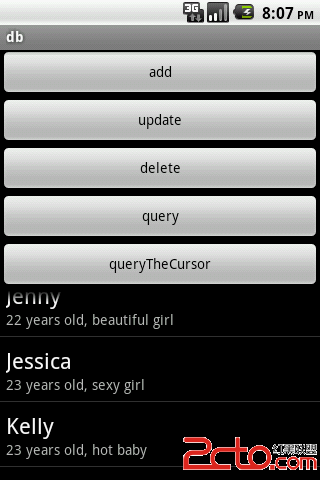
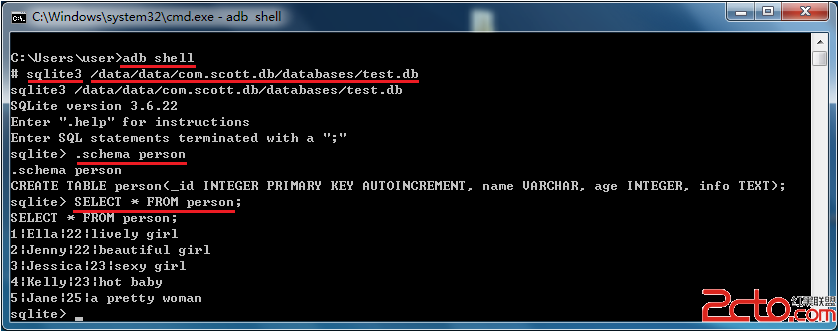
 在Android中用Kotlin的Anko運行後台任務(KAD 09),kotlinanko
在Android中用Kotlin的Anko運行後台任務(KAD 09),kotlinanko
在Android中用Kotlin的Anko運行後台任務(KAD 09),kotlinanko作者:Antonio Leiva 時間:Jan 19, 2017 原文鏈接:h
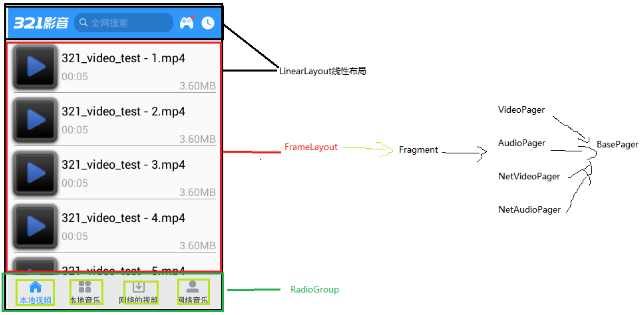 手機影音2--軟件架構分析,影音2--架構分析
手機影音2--軟件架構分析,影音2--架構分析
手機影音2--軟件架構分析,影音2--架構分析 1.標題欄 <?xml version=1.0 encoding=utf-8?> <com.atgui
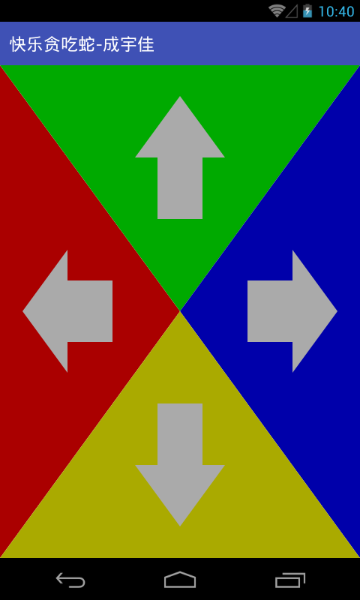 Android快樂貪吃蛇游戲實戰項目開發教程-06虛擬方向鍵(五)繪制方向鍵箭頭,android-06
Android快樂貪吃蛇游戲實戰項目開發教程-06虛擬方向鍵(五)繪制方向鍵箭頭,android-06
Android快樂貪吃蛇游戲實戰項目開發教程-06虛擬方向鍵(五)繪制方向鍵箭頭,android-06本系列教程概述與目錄:http://www.cnblogs.com/
 Android實現通過浏覽器點擊鏈接打開本地應用(APP)並拿到浏覽器傳遞的數據
Android實現通過浏覽器點擊鏈接打開本地應用(APP)並拿到浏覽器傳遞的數據
Android實現通過浏覽器點擊鏈接打開本地應用(APP)並拿到浏覽器傳遞的數據 點擊浏覽器中的URL鏈接,啟動特定的App。 首先做成HTML的頁面,頁面內容&